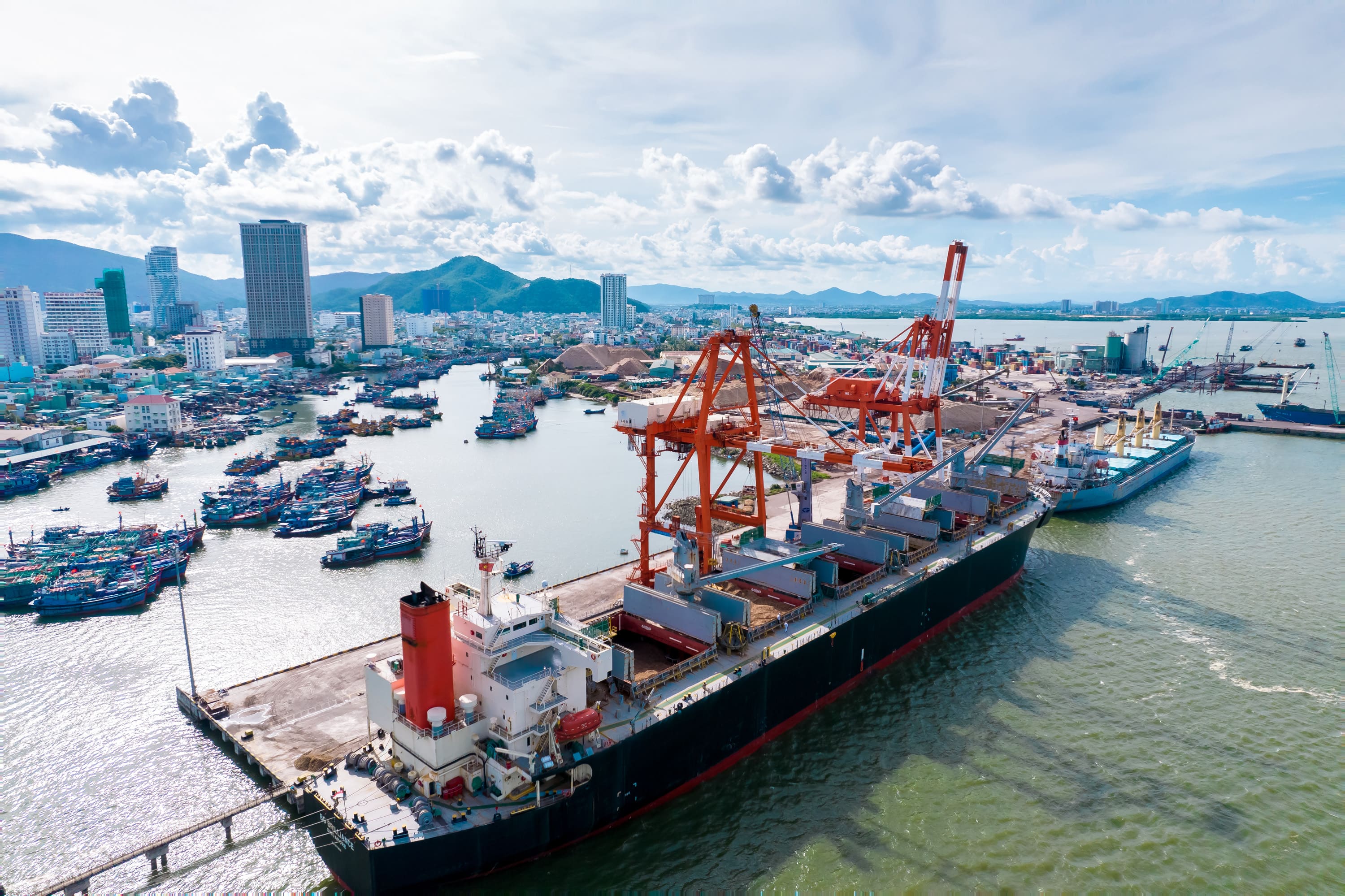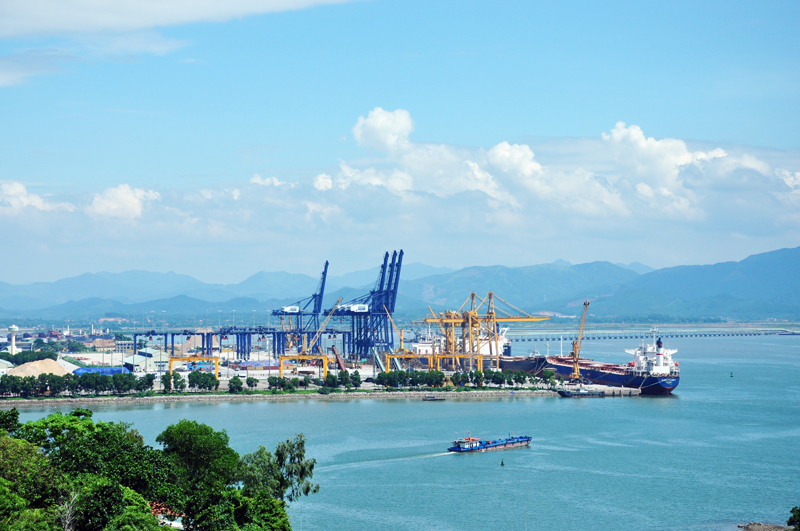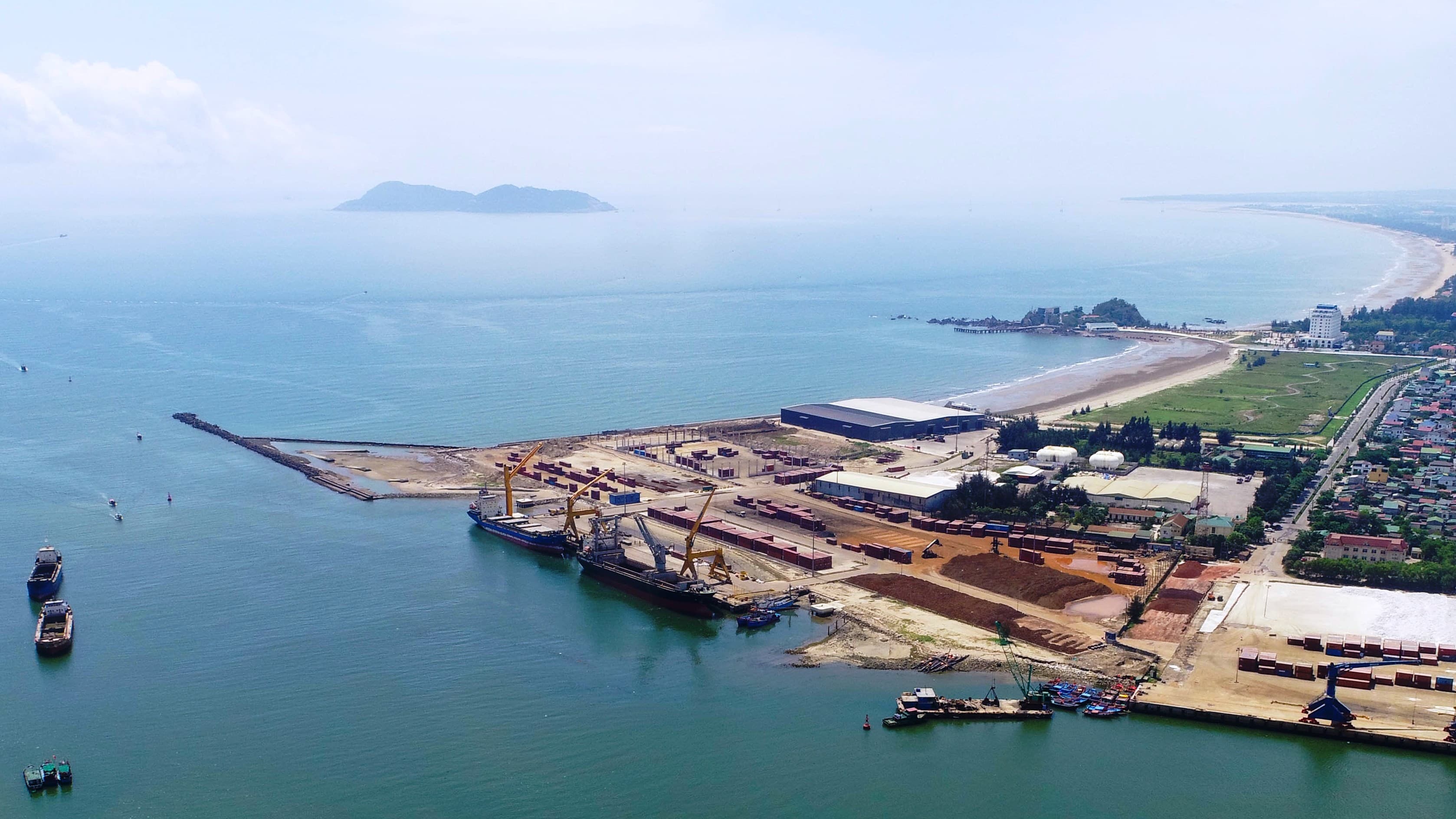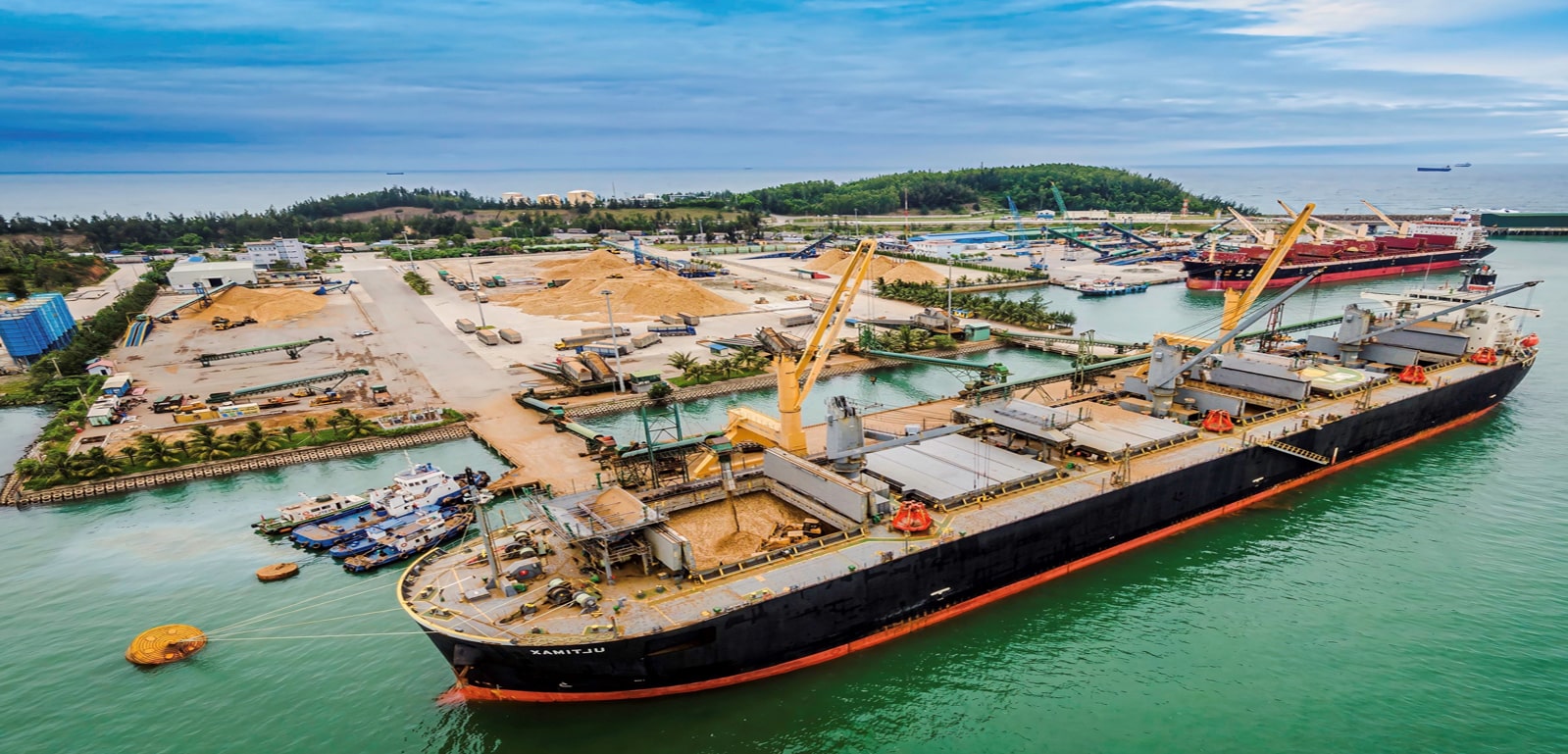One of the strengths of the Vietnamese economy is the seaport system stretching across the country from North to South. So which seaport in Vietnam is the largest and which is the deepest? Join SIMBA to learn about the top 10 seaports in Vietnam in this article.
1. Hai Phong Port

Built by the French in 1874, Hai Phong port is now the most modern container port in Northern Vietnam. With facilities including an advanced network system, modern equipment technology, 200 CCTV cameras, information and personnel management system, Hai Phong Port is always a convenient location, ensuring safety and suitable for the purpose of transporting international trade transactions. Currently, Hai Phong Port consists of 5 branches.
The port area has 21 piers with a total length of 3,567m with a design pre-berth depth of -7.5m to -9.4m. The total container yard area at Chua Ve and Tan Vu port branches is 712,110m2 and 3,300m2 for CFS warehouse at Chua Ve port.
As the seaport with the largest cargo traffic in the North of Vietnam, Hai Phong port is capable of receiving about 10 million tons/year, of which, Hoang Dieu Port branch accounts for nearly 60% of loading and unloading cargo. At the same time, the largest ship size can receive 40,000 DWT at Lan Ha transshipment area, and the lowest with 700 DWT at Bach Dang pontoon pier.
Towards the goal of stable and sustainable development, Hai Phong Port is implementing the investment project of Dinh Vu Port with 5 piers and lifting the ship's load to 55,000 DWT and in the future with 100,000 DWT in Lach Huyen and investments in information technology infrastructure.
2. Vung Tau Port

This is a cluster of ports with 4 areas including 10 large ports serving the needs of oil and gas trade and business in the Southeast of Vietnam.
At the same time, Vung Tau Port is 1 of 2 international gateways in Vietnam. On April 10, the successful reception of the Yang Ming Wellhead ship with a capacity of 160,000 tons, carrying a capacity of 14,000 TEUs to dock at Tan Cang – Cai Mep Thi Vai port (CMTV) proved the ability to handle and unload container ships at CMTV port in particular Vung Tau port in general.
According to the plan, in 2020, in addition to 4 wharf areas Cai Mep – Sao Mai Ben Dinh, Phu My – My Xuan, Dinh River, and Dam – Con Dao wharf area, Vung Tau port will expand 2 more wharf areas in Long Son and Sao Mai – Ben Dinh to serve the petrochemical industry and passenger transportation.
3. Van Phong Port

Located close to international routes with the shortest trans-Pacific distance compared to Hong Kong and Singapore, Van Phong Port has the potential to become an international transit port in Vietnam.
The construction of Van Phong Port restarted at the end of 2009 and is planned to be completed in 2020 in two phases. As expected, the international transshipment port in Vietnam is capable of receiving 5 million TEUs / year, with 8 berths for container ships with a capacity of up to 12,000 TEUs and 8 berths for feeder ships with a total port area of 405 hectares and a total berth length of up to 5,710m.
Currently, Tan Phong Port has completed two berths: My Giang and Doc Let, Ninh Thuy.
4. Quy Nhon Port

Located in the center of Quy Nhon city – Binh Dinh province and possessing natural conditions as well as a favorable geographical location, Quy Nhon port is recognized as the leading port in the Central region with the ability to receive ships with a tonnage of 30,000 DWT to 50,000 DWT.
The port has a total area of 306,568m2; the total warehouse area occupies 30,732m2 with CFS warehouse 1,971m2; The yard area is 201,000m2 with a container yard occupying 48,000 m2.
In the future, it is expected to invest about VND 180 billion in Quy Nhon port to upgrade the ship flow capable of receiving ships of 5,000 tons in and out of the port safely and smoothly. At the same time, after being under the investment management of Vietnam Maritime Corporation, Quy Nhon Port is determined to become an international port in the South Central region, promoting opportunities to develop Vietnam's maritime transport industry.
5. Quang Ninh Port

Quang Ninh Port is a deep-sea port located in the northern key economic region of Vietnam. According to the plan of the Ministry of Transport, Quan Ninh Port holds the 2nd position in the group of important seaports in the North of Vietnam, after Hai Phong in the central position.
The port has a total area of 154,700m2; the Total warehouse reaches 5400m2 and the container yard is up to 49000m2. With favorable natural and climatic conditions and available facilities, Quang Ninh Port is constantly developing, and improving technical and technological systems while ensuring close security to improve its service quality.
6. Sai Gon Port

Saigon Port is the main port of South Vietnam, playing a key role in connecting maritime transport of the Southeast region and the Mekong Delta.
Since it first opened in 1860 under French colonial rule, Saigon Port today has become an international port. The total area is 500,000m2 including 5 port areas (Cruise Passengers, Dragon House Khanh Hoi, Tan Thuan, Tan Thuan 2, and Phu My Steel Port) with a 3,000m pier, 30 pontoon berths, and 280,000m2 warehouse.
With the motto of sustainable development, as the main maritime gateway of Vietnam, besides setting itself the goal of improving service standards, Saigon Port will develop and exploit a deep-water port and become a national strategic port in the South of Vietnam.
7. Cua Lo Port

Cua Lo port belongs to Nghe An Port cluster and is approved as an important container port in the group of seaports in the North Central region of our country, with a port length of 3,020m with the capacity to receive ships with a tonnage of 30,000 DWT – 50,000 DWT.
At the working meeting of Prime Minister Nguyen Xuan Phuc in Nghe An in February, the master plan of Cua Lo port cluster will be implemented. According to estimates, the plan is calculated by 2030 with the goal of becoming an international seaport, receiving ships up to 10,000 DWT as well as meeting the import and export needs of Nghe An province, neighboring provinces in the North Central region, attracting a part of goods from Laos and Northeast Thailand.
8. Dung Quat Port

Located in Quang Ngai province, Dung Quat port is the national general seaport of Vietnam. Every year, the number of goods loaded through the port reaches about 0.6 million tons, and the average number of ships docked at the port is 150 ships/year.
Dung Quat port consists of 2 port areas with a total warehouse area of 3,600m2 and a port yard of up to 50,000m2. Pier 1 is the main port area in Dung Quat Bay with the capacity to receive ships of 70,000 DWT with the function of loading and unloading, transporting all goods and equipment to build Dung Quat Oil Refinery. Meanwhile, Pier 2 at the mouth of Sa Ky Sea has the capacity to receive ships of 3,000 DWT, mainly for local maritime transport needs.
According to the Government's plan, 1 port area in My Han Bay in the future will become part of Dung Quat port.
9. Chan May Port

Chan May Port is a general seaport of our country at the location between the two cities of Hue–Da Nang. In addition to the ability to receive cargo container ships with a tonnage of 50,000 DWT, Chan May port is also selected by the Asian Cruise Association to build a stopover for yachts in Southeast Asia with the ability to receive international cruise ships has a length of up to 362m and a total capacity of 225,282 GRT.
Currently, Chan May Port has Berths 1 and 2 and the Berth 3 project will be completed in 2018. According to the plan, by 2020, Chan May port will have 6 general cargo berths with a length of 1,680m. By 2030, this port will have 8 general cargo berths with a length of 2,280 m. It is forecasted that by 2020, the volume of cargo through Chan May port will reach 7.4 million tons/year.
10. Da Nang Port

In the last position, Da Nang port also belongs to the group of general ports, the focal point of the whole country. Da Nang port has three berths: Tien Sa – Son Tra, Lien Chieu, and Tho Quang, of which, Tien Sa – Son Tra port is the main wharf area with a total yard area of 178,603m2 and 14,285m2 for the total warehouse area.
With the goal of being the most modern seaport in Central Vietnam, Da Nang Port is currently implementing the investment project to expand Tien Sa Port phase 2 to 2018, increasing the receiving ship capacity to 50,000 DWT, container ships to 3000 TEU, and at the same time, establishing a transshipment warehouse area with an area of 30h to 50ha in the period of 2015-2020.









